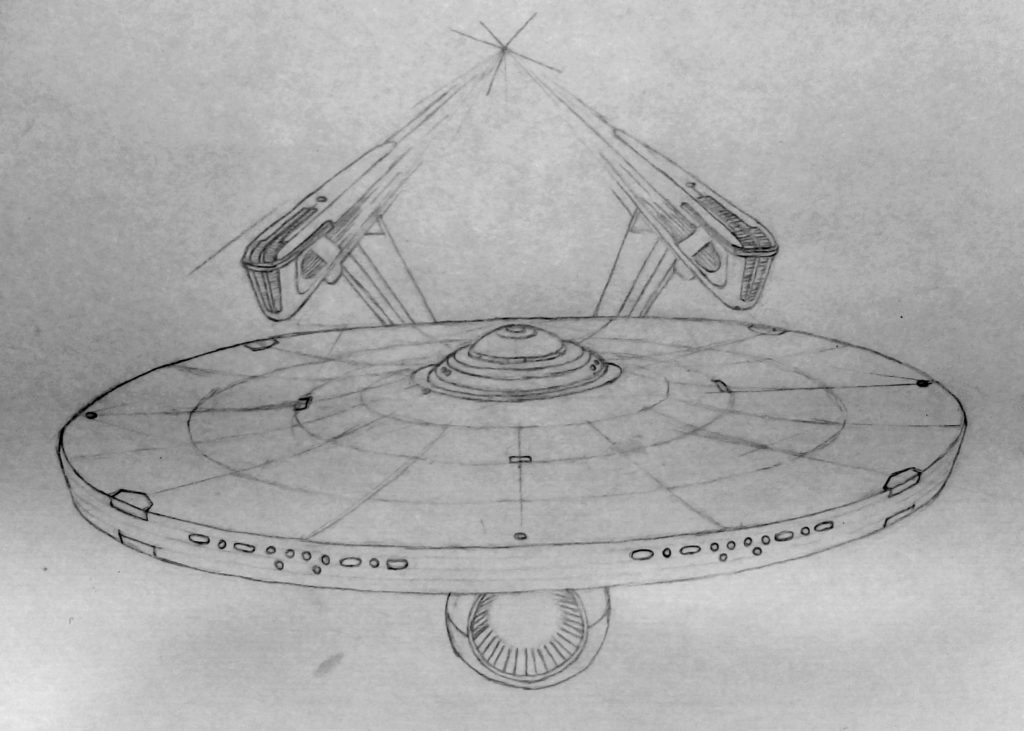I’ve drawn this ship many, many times. Mostly in grade school and high school while bored. I don’t have any of those old drawings around anymore, but I suspect this is my best rendition of it.
Part of that, I hope, is that I’m simply getting better at drawing things like this.
But part of it is probably also that I had access to a lot of reference material online, resources I didn’t have access to as a kid. I studied my subject very closely, more closely than I ever had before.
* * *
I think I saw my first vector-drawing program in 1989. The Michael Keaton Batman had just come out, the drawing program has a quarter-ellipse drawing tool, and so the first vector art I ever made was the Batman logo, made of nothing but straight lines and quarter-ellipses.
Later on, I would reproduce logos as a way of learning whatever new vector drawing programs I found. And when I discovered 3d modeling, I modeled the starship Enterprise.
I’ve made the Enterprise in Alias Sketch, AutoCad, TrueSpace, 3DS Max, Blender, Strata 3D, and even a custom modeling program I once worked on.
I’ve drawn the Enterprise on paper more times than I can count.
And this work has no value. None at all. It never occurred to me, while making these copies of logos and spaceships that I might want to spend my time producing work that had value. I was just learning.
* * *
I tried drawing many of the details of the Enterprise above from memory… and I could never do it. I always got something dramatically wrong. You’d think, after so many times drawing this, I’d be able to just do it… but to my surprise, I can’t.
I forget if I’ve mentioned it here before, but I cannot make pictures in my head. I only recently discovered that other people can. For a great overview of what it’s like to realize that, check out this Facebook post from Blake Ross.
I have no desire to dwell on it; I don’t see it as a huge limitation or disability or anything. But it does behoove me to keep it in mind — for example, I’m reading articles about learning to draw or write or compose music and the instructor mentions a technique involving visualizing something in your head, I’m going to have to remember to find a different strategy.
When drawing, I may need visual references more than most illustrators — even if those visual references are sketches I myself made. If I’m designing something, rather than just copying, I should keep my initial quarter-sized thumbnails around when making notecard-sized sketches. And keep those sketches around when making full renderings filling a page. I can’t keep my initial design explorations in my head, so I need to keep them somewhere out of my head.
* * *
For whatever reason, it never occurred to me to take this copying-things approach with music composition, not until yesterday. I have always been trying to learn to compose music by producing music for games. I decided last night it’s time to take a step back. It’s time to copy things.
So last night, I got to work reproducing this one track from Tomorrowland. After an hour, I had one measure. Which was incomplete. It was kind of stunning, how little I got done. My problem wasn’t writing; my problem was listening.
I can’t identify the instruments being used in the piece.
There are these frenetic arpeggios in the beginning and I can’t place all the notes.
My music composition software offers portato, marcato, and martele strings, but I have no idea what these styles sound like in real music.
Taking a further step back, it’s time to listen more. Not just listen to pieces and understand the melodies, but listen to the sound and learn how to deconstruct what’s going into any particular sound.
This is going to take a lot of willpower to do. I know me. I have a few things I’ve composed that I like, and I know that I’ll resent having to go back to the basics here because I can already do things. But doing isn’t my problem right now. Knowing is.
I can do things without really knowing what I’m doing, and that’s not good.
